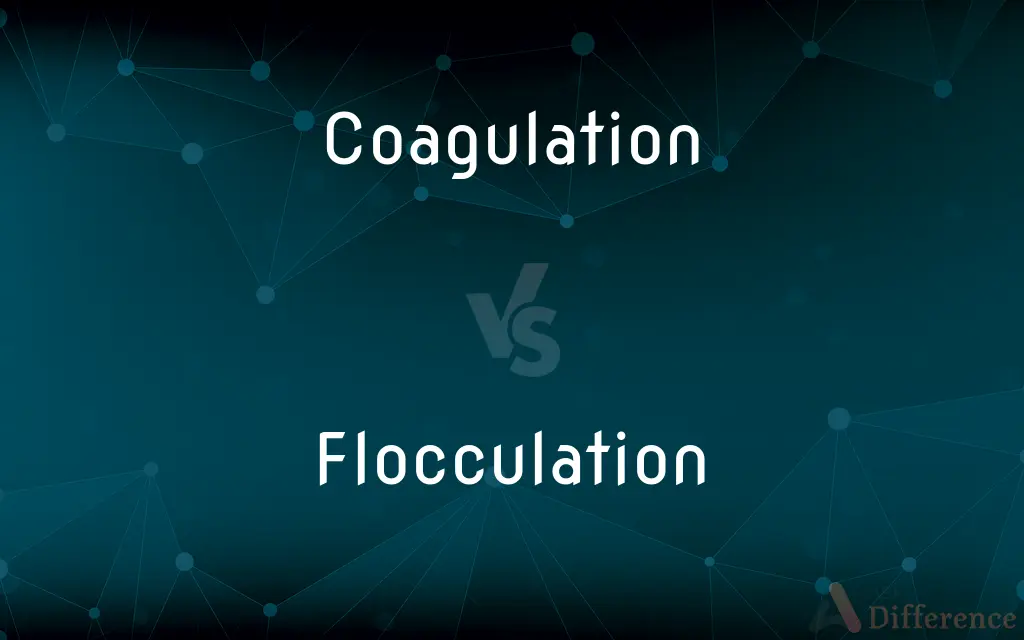Coagulation vs. Flocculation — What's the Difference?
By Tayyaba Rehman & Maham Liaqat — Updated on March 20, 2024
Coagulation involves the neutralization of charges to form clumps, while flocculation refers to the aggregation of these clumps into larger flocs.

Difference Between Coagulation and Flocculation
Table of Contents
ADVERTISEMENT
Key Differences
Coagulation is a chemical process used in water treatment to neutralize the charges on particles suspended in water, making them stick together to form small clumps. This is often achieved by adding coagulants like aluminum sulfate. Flocculation, on the other hand, is the physical process that follows coagulation, where these small clumps are gently mixed to encourage the formation of larger, settleable flocs through the addition of flocculants like polymers.
During coagulation, the goal is to destabilize the particles by neutralizing their charges, which prevents them from repelling each other. This allows the particles to come closer and start forming clumps. Whereas, during flocculation, the focus is on enhancing the physical conditions to promote the binding of these clumps into larger aggregates, which can be more easily separated from the water.
Coagulation is critical for the effective removal of fine particles and colloids from water, as these particles are too small and stable to be removed by filtration alone. Flocculation complements coagulation by increasing the size of the particle aggregates, making them large enough to be removed by sedimentation or filtration.
The effectiveness of coagulation depends on the choice of coagulant, pH levels, and the presence of other substances in water. Flocculation's effectiveness, however, hinges more on the mixing speed and time, which must be carefully controlled to avoid breaking up the forming flocs.
Both processes are essential steps in water treatment, but they serve different purposes and require different conditions. Coagulation addresses the chemical stabilization of particles, while flocculation focuses on the physical aggregation process, leading to more efficient sedimentation and filtration.
ADVERTISEMENT
Comparison Chart
Definition
Chemical process to neutralize charges and form small clumps.
Physical process to aggregate clumps into larger flocs.
Purpose
Destabilize particles to prevent repulsion and encourage clumping.
Enhance the size of particle aggregates for easier removal.
Key Agents
Coagulants (e.g., aluminum sulfate).
Flocculants (e.g., polymers).
Process Type
Chemical neutralization.
Physical aggregation.
Dependence
PH levels, coagulant type, water composition.
Mixing speed and time, physical conditions.
Role in Water Treatment
Prepares particles for removal by destabilizing them.
Facilitates the removal of particles by forming larger aggregates.
Main Consideration
Chemical compatibility and conditions for effective charge neutralization.
Optimal physical conditions for effective aggregation without breaking flocs.
Compare with Definitions
Coagulation
Dependent on chemical reactions.
The effectiveness of coagulation varies with the pH of the water.
Flocculation
Relies on gentle mixing to be effective.
Proper flocculation requires controlled stirring to form bigger flocs.
Coagulation
Aims to destabilize suspended particles.
Coagulation disrupts the stability of particles, allowing them to aggregate.
Flocculation
Critical for sedimentation and filtration processes.
Flocculation makes it easier to filter out contaminants by increasing particle size.
Coagulation
Essential for removing fine particles in water treatment.
Coagulation is the first step in water purification to remove colloids.
Flocculation
A process that encourages the agglomeration of coagulated clumps into larger flocs.
Flocculation follows coagulation to form larger particles that can settle.
Coagulation
A chemical process that neutralizes the charge of particles in water.
Adding aluminum sulfate during coagulation causes suspended particles to clump together.
Flocculation
Focuses on physical aggregation.
The flocculation process physically aggregates particles without altering their chemical properties.
Coagulation
Uses specific chemicals called coagulants.
Coagulants like ferric chloride are commonly used in coagulation.
Flocculation
Uses flocculants to enhance particle aggregation.
Polymer flocculants help in binding small clumps into larger ones during flocculation.
Coagulation
To cause transformation of (a liquid or sol, for example) into or as if into a soft, semisolid, or solid mass.
Flocculation
Flocculation, in the field of chemistry, is a process by which colloidal particles come out of suspension to sediment under the form of floc or flake, either spontaneously or due to the addition of a clarifying agent. The action differs from precipitation in that, prior to flocculation, colloids are merely suspended, under the form of a stable dispersion, in a liquid and are not truly dissolved in solution.Coagulation and flocculation are important processes in water treatment with coagulation aimed to destabilize and aggregate particles through chemical interactions between the coagulant and colloids, and flocculation to sediment the destabilized particles by causing their aggregation into floc.
Coagulation
To become coagulated
As it cooled, the sauce began to coagulate.
Flocculation
To cause (individual particles of clay) to aggregate into clotlike masses or precipitate into small lumps.
Coagulation
The precipitation of suspended particles as they increase in size (by any of several physical or chemical processes)(e.g. of proteins)
Flocculation
To cause (clouds) to form fluffy masses.
Coagulation
Similar solidification of other materials (e.g. of tofu).
Flocculation
To form lumpy or fluffy masses.
Coagulation
The change from a liquid to a thickened, curdlike, insoluble state, not by evaporation, but by some kind of chemical reaction; as, the spontaneous coagulation of freshly drawn blood; the coagulation of milk by rennet, or acid, and the coagulation of egg albumin by heat. Coagulation is generally the change of an albuminous body into an insoluble modification.
Flocculation
A condition in which clays, polymers or other small charged particles become attached and form a fragile structure, a floc.
Coagulation
The substance or body formed by coagulation.
Flocculation
The process by which small particles of fine soils and sediments aggregate into larger lumps.
Coagulation
The process of forming semisolid lumps in a liquid
Flocculation
The process of flocculating; forming woolly cloudlike aggregations
Common Curiosities
What is flocculation?
Flocculation is the physical process of gently mixing coagulated clumps to form larger aggregates or flocs.
Why are coagulants added to water?
Coagulants are added to water to neutralize the charge on suspended particles, facilitating their aggregation.
What role do flocculants play in water treatment?
Flocculants aid in binding the small clumps formed during coagulation into larger flocs that can be more easily removed by sedimentation or filtration.
How is the flocculation process controlled?
The flocculation process is controlled by adjusting the mixing speed and duration to ensure optimal floc formation without breaking the aggregates.
What types of coagulants are commonly used?
Common coagulants include aluminum sulfate, ferric chloride, and various polymeric coagulants.
How do coagulation and flocculation impact water clarity?
These processes significantly improve water clarity by removing fine particles and colloids that cause turbidity.
What is coagulation?
Coagulation is a chemical process that neutralizes the charges of particles in water, causing them to clump together.
Can flocculation occur without coagulation?
Flocculation typically requires coagulation to first destabilize the particles; without it, effective flocculation is challenging due to the stability of the particles in suspension.
Can coagulation and flocculation be used in wastewater treatment?
Yes, these processes are also crucial in wastewater treatment to remove suspended solids and other contaminants.
What factors affect the effectiveness of coagulation?
The effectiveness of coagulation depends on the type of coagulant used, the pH of the water, and the presence of other substances.
Are there environmental concerns associated with coagulation and flocculation?
The chemicals used in coagulation and flocculation can pose environmental concerns if not handled or disposed of properly.
How do coagulation and flocculation fit into the water treatment process?
They are essential early steps in water treatment, preparing the water for sedimentation, filtration, and disinfection by removing suspended particles.
What are the challenges in coagulation and flocculation processes?
Challenges include optimizing chemical dosages, mixing conditions, and managing the disposal of sludge produced during the process.
What are the main differences between coagulation and flocculation?
Coagulation is a chemical process focusing on particle charge neutralization, while flocculation is a physical process aimed at particle aggregation.
Share Your Discovery

Previous Comparison
Clarinet vs. Flute
Next Comparison
Biography vs. ObituaryAuthor Spotlight
Written by
Tayyaba RehmanTayyaba Rehman is a distinguished writer, currently serving as a primary contributor to askdifference.com. As a researcher in semantics and etymology, Tayyaba's passion for the complexity of languages and their distinctions has found a perfect home on the platform. Tayyaba delves into the intricacies of language, distinguishing between commonly confused words and phrases, thereby providing clarity for readers worldwide.
Co-written by
Maham Liaqat














































